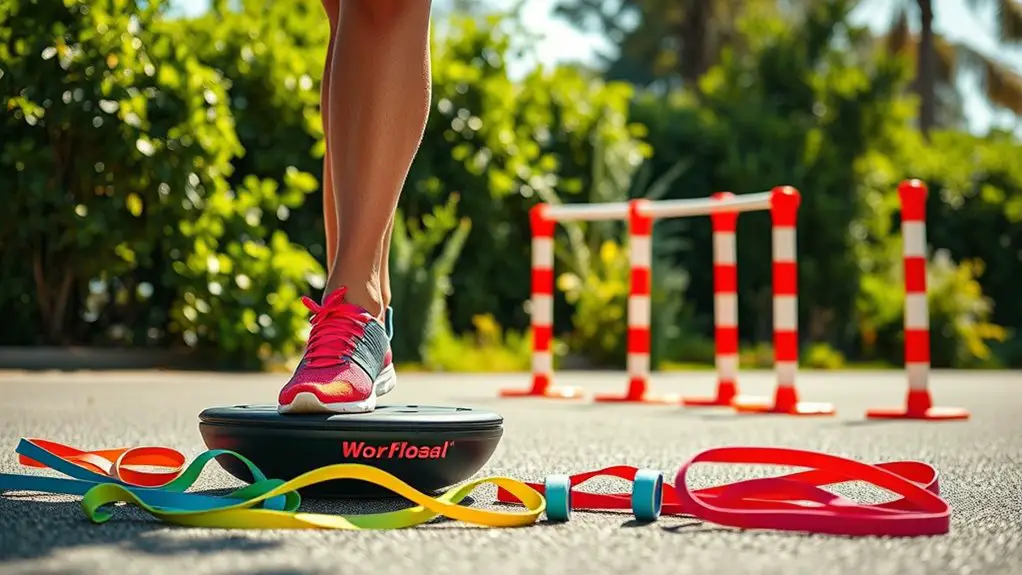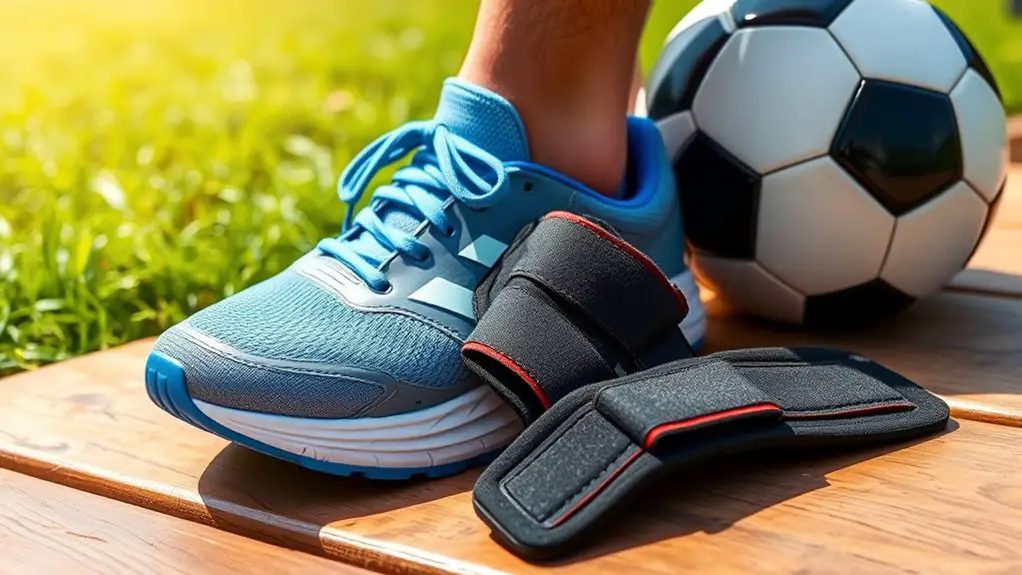To develop ankle strength for better agility, focus on exercises that target both strength and flexibility. Start with basic exercises like ankle alphabets, calf raises, and resistance band movements to build a solid foundation. Incorporate advanced techniques like plyometric drills and balance training to enhance stability. Remember to warm up properly and avoid common mistakes like neglecting recovery. By following these approaches, you'll lay the groundwork for improved performance and confidence. There's more to explore about ideal training strategies.
Understanding the Importance of Ankle Strength
Ankle strength is essential for overall stability and mobility. When you strengthen your ankles, you're not just preventing ankle injuries; you're revealing a world of freedom in your movements. Strong ankles support your body's weight and allow for smoother shifts in various activities, whether you're running, jumping, or dancing. This stability translates to improved athletic performance, giving you the confidence to push your limits without the fear of setbacks. Additionally, proper warm-up techniques can further enhance your ankle strength and help prevent injuries.
Anatomy of the Ankle: Key Muscles and Ligaments
Understanding the anatomy of your ankle is essential for developing strength and preventing injuries. Knowing the key muscles and ligament types can help you optimize your agility and keep your movements fluid and free. Here are four vital components of ankle anatomy:
Understanding your ankle's anatomy is crucial for strength, injury prevention, and enhancing agility in your movements.
- Tibialis Anterior: This muscle helps with dorsiflexion, allowing you to lift your foot.
- Gastrocnemius and Soleus: These muscles work together to facilitate plantarflexion, essential for pushing off the ground.
- Lateral Ligaments: Comprising the anterior talofibular, calcaneofibular, and posterior talofibular ligaments, these support ankle stability.
- Medial Ligaments (Deltoid Ligament): This complex provides support on the inside of the ankle, protecting against excessive eversion. Additionally, enhanced proprioception can significantly improve your ankle stability during movements, reducing the risk of injury.
Basic Ankle Strengthening Exercises
Building strength in the ankle is essential for improving stability and performance in various activities. Here are some basic ankle strengthening exercises you can easily incorporate into your routine. These movements, including resistance band exercises and bodyweight movements, will help you build a solid foundation for agility.
| Exercise | Description |
|---|---|
| Ankle Alphabet | Trace letters with your toes |
| Resistance Band Flexion | Use a band to resist ankle movements |
| Calf Raises | Stand on the edge of a step, raise heels |
| Toe Taps | Tap your toes on the ground while seated |
| Heel Walks | Walk on your heels for added strength |
Try these exercises regularly, and you'll notice improved ankle strength and better overall performance. Additionally, proper warm-ups can further enhance your performance and reduce the risk of injuries. Enjoy the freedom that comes with stronger ankles!
Advanced Techniques for Ankle Development
While basic exercises lay a solid foundation, incorporating advanced techniques can greatly enhance your ankle strength and stability. By pushing your limits, you'll gain the agility you crave. Here are four advanced techniques to evaluate:
- Plyometric Drills: Engage in box jumps or lateral hops to improve explosive strength and quickness.
- Resistance Bands: Use bands for lateral walks and ankle strengthening exercises to develop controlled movement and stability.
- Single-Leg Hops: Practice hopping on one leg to challenge your balance and enhance ankle resilience.
- Dynamic Stretching: Incorporate dynamic stretches like leg swings to increase flexibility while preparing your ankles for intense activity. Additionally, these techniques will help in developing fast-twitch muscle fibers crucial for improved performance.
Incorporating Balance Training for Agility
To boost your ankle strength, incorporating balance training is essential for enhancing agility. You'll find that specific exercises not only improve your stability but also help you progress your balance skills over time. Focusing on these elements can greatly impact your overall performance and reduce injury risk. Additionally, prioritizing mobility training can further enhance your adaptability and resilience, leading to better performance outcomes.
Importance of Balance Training
Incorporating balance training into your routine is crucial for enhancing agility and overall ankle strength. By focusing on balance techniques and proprioceptive training, you'll develop greater control and stability, which are essential for athletic performance. Here are four key benefits:
- Improved Coordination: Balance training enhances your body's ability to coordinate movement, making you quicker and more agile.
- Injury Prevention: Strengthening your ankles through balance work reduces the risk of sprains and other injuries.
- Enhanced Performance: A strong foundation leads to better performance in various sports and activities.
- Boosted Confidence: Mastering balance techniques allows you to move freely, increasing your confidence in physical pursuits.
Embrace balance training to reveal your full potential!
Exercises to Enhance Balance
Balance exercises are essential for building agility and enhancing your overall ankle strength. Incorporating balance drills into your routine can give you the freedom to move confidently and efficiently. Start with simple stability exercises, like standing on one leg or using a balance board. These not only challenge your coordination but also strengthen the muscles around your ankles. As you progress, try dynamic movements such as lateral hops or single-leg squats to further improve your balance. Remember, the goal is to engage your core and maintain control while moving. By committing to these balance drills, you'll cultivate the stability needed for better agility, allowing you to navigate any physical challenge with ease. Embrace these exercises and release your true potential!
Progressing Your Balance Skills
Building on your newfound balance skills can elevate your agility to the next level. To truly harness your potential, incorporate these balance drills into your routine, focusing on proprioceptive training:
- Single-leg stands: Hold your balance on one leg, gradually increasing time.
- Balance board exercises: Use a balance board to challenge stability and engage multiple muscle groups.
- Dynamic movements: Combine balance tasks with actions like reaching or twisting to enhance coordination.
- Closed-eye exercises: Perform balance drills with your eyes closed to heighten your proprioceptive awareness.
Stretching and Flexibility for Ankle Health
Stretching and flexibility exercises are essential for maintaining ankle health, as they help improve range of motion and prevent injuries. Incorporating static stretching into your routine can enhance flexibility, while dynamic flexibility activities keep your ankles ready for action. Try mobility drills and ankle rolls to warm up your joints effectively. Don't forget to include calf stretches, as tight calves can limit your ankle's potential.
Using resistance bands can help strengthen the surrounding muscles while also improving flexibility. Engage in proprioceptive training to enhance your body's awareness of ankle positioning, vital for agility. Finally, consider fascia release techniques to alleviate tightness, promoting better movement. By dedicating time to these exercises, you're not just strengthening your ankles; you're embracing the freedom to move fluidly and confidently. Moreover, including flexibility training in your routine supports overall joint health and reduces the risk of injuries. So, get moving, and let your ankles thrive!
Common Mistakes to Avoid in Ankle Training
While improving flexibility and mobility is important for ankle health, it's equally essential to approach ankle training with care. Avoiding common mistakes can help you achieve your goals without injury. Here are four pitfalls to steer clear of:
Improving ankle flexibility and mobility is crucial, but care and awareness are key to avoid injury.
- Skipping Warm Ups: Jumping straight into exercises without warming up can lead to strain. Always prepare your muscles first.
- Improper Footwear: Wearing the wrong shoes can compromise your stability and technique. Invest in proper footwear suited for your activity.
- Neglecting Recovery: Your body needs time to heal. Ignoring recovery can lead to overtraining risks and setbacks, especially after ankle sprains.
- Ignoring Pain: Pain is your body's way of signaling something's wrong. Don't dismiss it; listen and adjust your training accordingly.
Monitoring Progress and Setting Goals
To build effective ankle strength, it's vital to track your progress. You should set realistic milestones that challenge you without overwhelming you. This way, you can see improvements and stay motivated on your journey.
Track Strength Improvements
Tracking strength improvements is essential for anyone looking to enhance ankle stability and performance. By monitoring your progress, you can better understand your body's capabilities and set yourself free from limitations. Here are some effective ways to track your advancements:
- Regular Testing: Conduct strength tests every few weeks to measure your ankle stability.
- Performance Metrics: Keep a log of your agility drills and their completion times to assess improvements.
- Visual Documentation: Capture your exercises through videos; reviewing your form can highlight areas for growth.
- Feedback Loop: Seek input from coaches or trainers who can provide insights on your progress.
Set Realistic Milestones
Setting realistic milestones is essential for effectively monitoring your progress and achieving your goals. By setting achievable goals within realistic timelines, you'll not only stay motivated but also experience the freedom that comes from seeing your improvements. Here's a simple table to help you visualize your milestones:
| Milestone | Timeline |
|---|---|
| Start basic exercises | Week 1 |
| Increase repetitions | Week 2 |
| Add resistance training | Week 3 |
| Incorporate agility drills | Week 4 |
| Evaluate overall strength | Week 5 |
Frequently Asked Questions
How Long Does It Take to See Improvements in Ankle Strength?
It typically takes a few weeks to notice improvements in ankle strength, but it really depends on your training frequency and consistency. If you're tracking your progress regularly, you'll see changes more clearly. With dedicated workouts a few times a week, you might start feeling stronger ankles in as little as three to four weeks. Stay committed, and you'll enjoy the freedom that comes with enhanced strength and agility in your movements.
Can Ankle Strength Training Help Prevent Injuries?
Oh sure, who needs stable ankles, right? Just like a tightrope walker on a windy day, you might think ankle strength training's unnecessary. But hey, it can actually help prevent injuries! By tackling ankle instability through proprioceptive training, you're giving yourself a shot at freedom from those pesky sprains. Strengthening those little joints not only boosts performance but also keeps you on your feet—literally! So, why not embrace that stability?
Is It Safe to Train Ankles Every Day?
Is it safe to train your ankles every day? While daily training can boost strength, it's essential to listen to your body. Overworking without proper recovery periods can lead to fatigue or injury. Instead, consider mixing in lighter days or different exercises to give your ankles a break. Striking a balance lets you enjoy the freedom of movement while still building strength effectively. Remember, rest is just as important as training!
What Equipment Is Necessary for Effective Ankle Training?
Isn't it amusing how you can strengthen your ankles with just a couple of simple tools? For effective training, you'll want a balance board and resistance bands. The balance board's like a tightrope for your ankles, challenging your stability, while resistance bands add that extra push to build strength. With these tools, you'll find yourself enjoying the journey to better agility, freeing you to move with confidence and grace in every step you take.
Are There Age Restrictions for Ankle Strength Training?
There aren't strict age restrictions for ankle strength training, but you should consider your fitness level and any existing conditions. For youth training, focus on fun, engaging exercises that promote healthy development. Seniors, on the other hand, need to prioritize safety and may require modifications to avoid injury. Ultimately, it's about listening to your body and adapting your routine accordingly. Everyone deserves the freedom to strengthen their ankles at any age!




